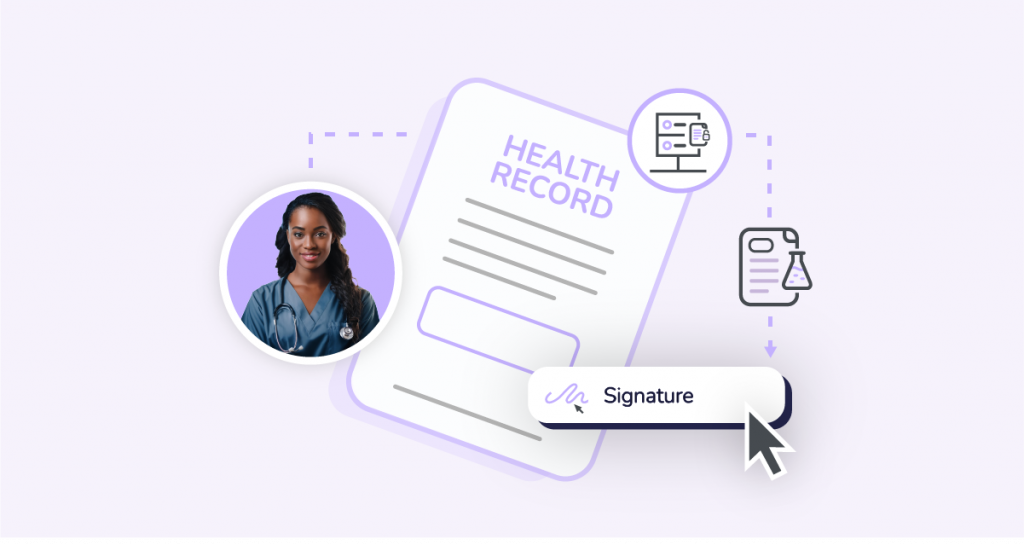Home | News and Insights | Are eSignatures HIPPA Compliant?

Posted 8th October 2024
HIPAA is a crucial regulation that ensures healthcare organizations and their partners implement appropriate processes and security measures to protect patient information. As technology advances, so do the threats to sensitive data, making it vital for those in the healthcare industry to fully understand HIPAA and remain compliant. In this guide, we will focus on electronic signatures, their compliance with HIPAA, and how they can meet the regulatory criteria to safeguard patient data effectively.
The Health Insurance Portability and Accountability Act (HIPAA), introduced in 2003, was designed to grant healthcare patients greater control over their protected health information (PHI). HIPAA establishes a comprehensive framework of regulations focused on ensuring the privacy and security of patient data.
When HIPAA was enacted, it provided detailed guidelines for covered entities—such as healthcare providers, doctors, and insurance companies—on how to manage PHI, particularly in electronic formats. The regulation is primarily divided into two key components: the Privacy Rule and the Security Rule.
Electronic protected health information is health information created, transmitted, stored, or received electronically that can clearly identify the individual to which it pertains. This includes health records which include relevant data such as patient medical records, laboratory results, treatment history, and billing information that is stored and sent electronically. PHI is protected under HIPPA regulations to maintain its security, confidentiality, integrity, and availability.
Yes, e-signatures can be HIPPA compliant and used across a wide range of healthcare settings, as long as certain conditions are met. Additionally, there is no set guidance for how e-signatures should be used to maintain compliance. Therefore, it is the responsibility of the covered entity to ensure that when electronic signatures are used, they result in secured, legally binding contracts. According to the Department of Health and Human Services (HHS), “the Privacy Rule generally allows for electronic documents, including business associate contracts, to qualify as written documents for purposes of meeting the Rule’s requirements.”
In essence, this means that as long as electronic signatures comply with state laws regarding legality and security, they can be used to sign HIPPA documents. If these e-signatures and digital solutions uphold the integrity of PHI and do not violate HIPAA regulations, they are acceptable for use.
Electronic signatures and digital solutions provide healthcare organizations and professionals with an effective way to validate forms while ensuring compliance with HIPAA regulations. To ensure that e-signatures used within your organization are HIPAA-compliant, it is essential to verify their legality by following the standards outlined in the Electronic Signatures in Global and National Commerce Act (ESIGN Act) and the Uniform Electronic Transactions Act (UETA).
Both of these Acts confirm that electronic signatures and digital records are legally equivalent to handwritten signatures on physical documents. The ESIGN Act specifically permits the use of electronic signatures across all 50 U.S. states when federal law applies.
These regulations provide secure methods for verifying the identity of signers. Significantly reducing the risk of tampering and ensuring the integrity of documents. As a result, secure electronic signature solutions are considered valid and legally binding.
Many states also have their own additional regulations in relation to electronic signatures. And it’s important to be aware that a patient’s e-signature is classed as PHI under HIPPA when stored with other individually identifiable health data.

Electronic signatures must meet the HIPPA compliance checklist of conditions below to effectively adhere to the regulation.
Covered entities must have a suitable system for identity verification of any parties involved in a document transaction. This helps to avoid the risk of disputes regarding whether the individual who has entered the agreement had the relevant authority to do so. Implementing a specialist e-signature software like eSign can also resolve this issue. eSign has a wide range of beneficial features including multi-factor authentication via SMS or email and password protection, which ensures that only the intended recipient of the document can access it.
In addition to digital documents complying with federal rules for electronic signatures, they should also demonstrate the signer’s intent to sign the document. And ensure they receive an emailed copy of the contract. Covered entities should also seek legal advice about any state or local laws that may impact the use and compliance of e-signatures under the HIPPA regulation.
To meet HIPAA compliance, electronic signatures must include a comprehensive audit trail that records critical details like the date, time, location, and IP address of the signature. This ensures the document’s legal authenticity and prevents the signer from denying their involvement. Moreover, securing authorizations for the disclosure of PHI reduces the risk of future disputes. Providing the signer with a copy of the completed document adds another level of protection, enhancing security and transparency while minimizing the chances of repudiation.
Covered entities need to implement a secure system that prevents any tampering with a document after it has been digitally signed, maintaining its integrity both in transit and storage. This is similar to the safeguards referred to in the HIPPA Security Rule and treated with the same level of care and importance.
This condition is about copies of signed documents being stored on the servers of e-signature providers. All evidence that supports the signature should be under the full control of the covered entity. Allowing them to ensure the integrity of the PHI.
In addition to understanding how to comply with HIPAA, it’s also important to recognize what constitutes a violation. As these can lead to significant penalties. According to the HIPAA Journal, the most frequent violations arise from:
Being aware of these common violations can help organizations better safeguard patient data and avoid hefty fines.

Since the Privacy Rule in the HIPPA regulation generally permits for electronic documents to be recognized as equivalent to written documents. When it comes to meeting its requirements, there are several ways electronic signature software can be adopted and used across healthcare organizations. This includes but is not limited to:
Whilst achieving and maintaining HIPPA compliance is an important priority of healthcare organizations, there are more benefits to using e-signatures than just meeting regulatory requirements and protecting PHI. These include:
Ensuring that your systems and document processes are HIPAA compliant helps you avoid costly penalties while enhancing patient care within your organization. eSign’s industry-leading e-signature and digital document solution fully complies with HIPAA and legal requirements for electronic signatures. Making it a secure and reliable platform for healthcare organizations and providers.
To find out more about how eSign’s HIPPA compliant solution can benefit your organization, contact our digital transformation team today. They will be able to discuss your requirements and ensure you receive a tailored plan that meets your specific workflow needs. You can also get started with eSign by registering for our 14-day free trial. This will allow you to explore the features and functionality of the platform for yourself and see how it could work for your organization.